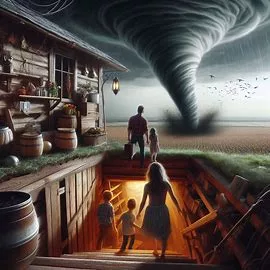Table of Contents

Understanding the risk of tornadoes in your area is foundational for effective preparedness. Tornadoes don’t just pop up out of nowhere, they are often tied to specific geographic and climatic conditions. In certain areas, the landscape and weather patterns make them more susceptible to these ferocious storms.
Taking stock of historical tornado data can offer valuable insights. Look into past tornado incidents in your region; this information can highlight seasonal patterns, the intensity of past tornadoes, and areas that have been repeatedly affected. In many places, this information is available through local meteorological departments or historical archives.
Paying attention to local weather patterns is just as essential. Tornadoes often accompany certain weather formations and seasons, like spring thunderstorms in the Midwest U.S. Staying informed about weather changes during these times increases your readiness. Combine this awareness with historical data, and you get a clearer picture of potential risks, helping you make informed decisions about safety and preparedness measures.
Stay Alert, Stay Safe: The Importance of Information
In the face of natural disasters, keeping informed can make all the difference. Community warning systems are an invaluable tool, providing real-time alerts that can give you the edge in reacting swiftly to tornado threats. Signing up for these alerts ensures news reaches you promptly, wherever you are.
Another crucial resource is a NOAA Weather Radio. This device broadcasts continuous weather information from the nearest National Weather Service office, making it an indispensable ally during storm seasons. It delivers automated, up-to-date alerts which might not be immediately available through other means, offering critical time to act.
It’s easy to overlook the importance of regular weather forecast checks. Whether you do it via your smartphone, TV, or radio, staying updated is crucial. Especially during the storm-prone months, daily forecast checks can mean the difference between preparedness and vulnerability. Simple habits like these form a solid backbone for tornado safety.
Crafting an Unyielding Safety Plan: From Family to Shelter
When it comes to tornado preparedness, having a solid emergency plan is everything. Start by developing a family emergency plan. This plan should outline how you’ll communicate and where you’ll meet if you get separated. Regularly practicing this plan reinforces what everyone needs to do when time is of the essence.
Designating a safe space in your home is another vital step. Ideally, this should be a basement area or an interior room on the lowest floor, away from windows. This spot should be known to all family members as the go-to location during a tornado warning, ensuring that when the time comes, there’s no hesitation or confusion.
An emergency kit is more than just a precautionary measure—it’s your lifeline. This kit should include essentials like water, food, a flashlight with extra batteries, and a first-aid kit. Don’t forget items like a whistle to signal for help and dust masks to protect from contaminated air. Keeping this kit accessible in your designated safe space ensures it’s ready when you need it most.
Beyond the Basics: Tackling Overlooked Tornado Preparedness
When preparing for tornadoes, it’s easy to focus on the obvious while forgetting smaller, yet crucial details. Understanding the visual and auditory signs of an impending tornado can be vital. Be on the lookout for funnel-shaped clouds or listen for a sound similar to a freight train. Recognizing these signals early can grant precious moments to ensure safety.
During a tornado, it’s easy to forget about basic safety instincts like avoiding windows. Many injuries occur from flying debris, so remember to steer clear of windows, even if it feels counterintuitive to looking outside.
In your preparations, don’t overlook the well-being of pets and livestock. Incorporate their needs into your emergency plans—keep extra pet food and supplies handy, and ensure they have a secure and safe space to take shelter.
Post-event safety measures are just as important. After a tornado has passed, debris poses a real threat. Wearing sturdy footwear reduces the risk of injury from sharp objects hidden in the rubble. Also, avoid entering damaged buildings until they’ve been deemed safe. Staying alert to these less obvious aspects ensures comprehensive preparedness that goes beyond just reacting to the immediate threat.
